Baby Oral Health for Parents
Your Baby’s Mouth
After the four front teeth come into the mouth, the next ones to come in are usually the two on the sides of the lower teeth. These are the bottom (mandibular) lateral incisors. This is followed by the two on the sides of the top teeth. These are the top (maxillary) lateral incisors. Timing of teething may be delayed up to six to nine months and is not unusual or cause for concern.
Remember to avoid using oral gels/teething products as they have been deemed unsafe for teething use in infants and children.

Grain of rice of toothpaste
Begin to brush your baby’s teeth as soon as they come in. Brush at least twice a day with a soft toothbrush. Use a small amount of fluoride toothpaste and a gentle circular scrubbing motion. The amount of toothpaste you should use is about the size of a grain of rice (see picture). Set a good example for your child by taking care of your own teeth and gums. You should take your child to the dentist for a first check-up by age one. If you do not have a dentist that sees young children, ask your doctor for a referral.
-
ORDER OF TEETH: As your child gets teeth, notice the order the teeth are coming in. The usual pattern is the bottom two front teeth, followed by the top two front teeth. Sometimes teeth come into the mouth in a different order; this is not unusual. However, front teeth should come in before the back ones. If your baby’s back teeth come in before the front ones, contact your doctor for a referral to a dentist. The dentist can determine whether there is a problem.
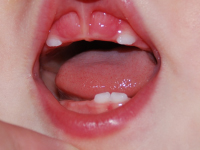
Teeth coming in out of order
- ERUPTION CYST: You may notice a soft fluid-filled swelling over a tooth that is coming in. The swelling may be pale-colored or bluish. This is likely an ‘eruption cyst’. Most eruption cysts disappear by themselves. If your baby shows signs of discomfort, check with your doctor or dentist.
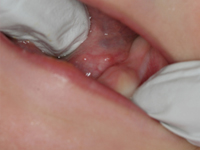
Eruption Cyst
- ENAMEL DEFECT: You should look closely at your child’s teeth on a regular basis. If you notice that the teeth are pitted or rough, or have yellow, brown, or white spots, you should contact your dentist. Your child may have enamel defects that can increase the risk of getting cavities. Babies born before 37 weeks have a higher chance of having enamel defects. Ask your dentist about how best to treat this.
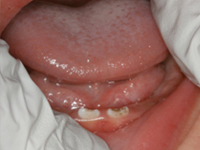
Enamel Defect
- CAVITIES: Your child’s baby teeth can develop cavities. Read the next section to learn how you can help prevent cavities in your child’s mouth. If your child does get cavities, it is important to have them treated. Your dentist can determine whether your child has cavities and how to treat them.
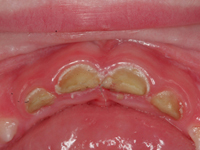
Cavities
General Oral Health Information
To help prevent cavities, avoid putting your child to bed with a bottle. If you put your child to bed with a bottle, use only water. You do not need to give your child juice at this age. Juice has a lot of sugar that can coat the teeth to cause cavities. Your child will get most of their nutrition from breast milk or formula. However, at this age, more and more of your child’s food will come from other sources. Remember that infants cannot chew food well. Make sure your infant can easily swallow food you give him/her.
Scientists have learned that mothers with cavities tend to have children with cavities. Also, these cavities are more severe. Mothers can pass cavity-causing germs to their children. This is why you should keep your mouth cavity free and visit the dentist regularly. Anyone else who cares for your child should do the same.
Fluoride helps prevent cavities. It is also considered a ‘vitamin’ for teeth. There are three main sources for fluoride—water, toothpaste, and professionally applied.
Water

Fluoridated City Water
Most city water has fluoride added. You should use tap water to mix with powdered infant formula. If your family uses well water, it may have too little or too much fluoride. Ask your doctor or dentist to run a test to see how much fluoride is in your well water. Your child may need a different amount of fluoride. Ask your doctor or dentist to help you learn the best way for your child to get the right amount. They may prescribe a supplement if needed. You might be able to give your child bottled water that has fluoride added. Here is a website to learn more about fluoridated bottled water. http://www.bottledwater.org/fluoride.
Toothpaste
Many brands of toothpaste have fluoride added. Check the label to make sure, or ask your doctor or dentist to recommend a brand to use. Use a small amount of fluoridated toothpaste to brush your child’s teeth. See the section on Begin Brushing Tab 2 in Your Baby’s Mouth section for more information.
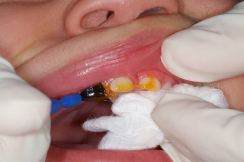
Fluoride Varnish
Professionally applied
Varnish is a type of fluoride that a dentist or doctor paints on your baby’s teeth. It can reduce (decrease) cavities in baby teeth by one-third when painted on at least twice a year for children at risk for cavities. Varnish can be applied as soon as the first tooth comes into the mouth. Ask your dentist or doctor about putting fluoride varnish on your baby’s teeth.
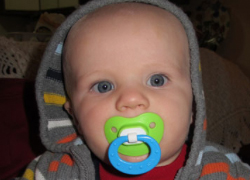
Using a pacifier after age one month may help protect against SIDS (Sudden Infant Death Syndrome). For your baby’s safety, avoid using a string around the neck to hold the pacifier. Stop use of a pacifier after one year. Using a pacifier past one year of age may cause your child to have teeth that do not fit together properly. It may also increase the risk of your child getting ear infections. To prevent tooth decay, avoid dipping the pacifier in any sweetened foods (e.g. honey, chocolate syrup, etc.).
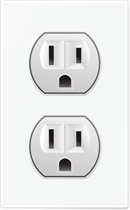
Children are beginning to crawl and learning to walk at this age. Make sure the child’s surroundings are safe. Cap electrical outlets and cushion sharp corners on tables and bookshelves. Cover bathtub nozzles. Do not force-feed your child because the utensils may damage his/her teeth and mouth. In case of a dental emergency, contact your doctor or dentist if you have a dental home.

Social and Emotional Growth (Development)
-
6 to 9 months
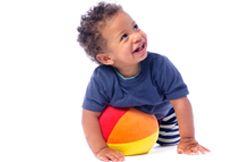
At this age, your child will get more active and have more body control. You and your child should begin forming sleep, feeding, and teeth-brushing routines. You should feed your baby at regular times. Using a pacifier may help your baby get to sleep. Encourage B’s before bedtime. The B’s are bath, bottle, brush (or wipe gums if teeth not present), book (or other quiet activity), and bed. You can change the order of these activities to fit your family routines. However, be sure that brushing (or wiping gums) comes right after feeding and before bed.
-
9 to 12 months
Your child will see you as the one giving comfort and confidence. You will be a ‘secure-base’ so your baby can feel safe and begin exploring. At this age, your baby may be wary of strangers, and he/she may cry or fuss when separated from you. Your child will likely crawl and may begin to walk. He/she will begin to explore his/her surroundings. See the section on Child Safety (Tab 5) in General Oral Health section for tips on how to protect your child.
Find a dentist that sees children at an early age. Take your child for his/her first dental check-up by their first birthday. Help prevent passing germs that cause cavities to your child by taking care of your teeth and gums.
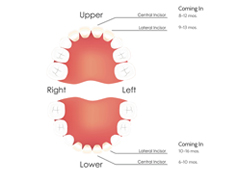
 Teething Table
Teething Table